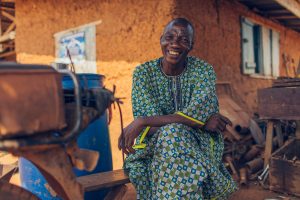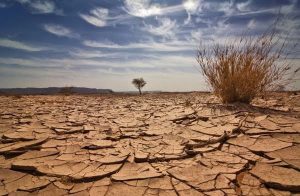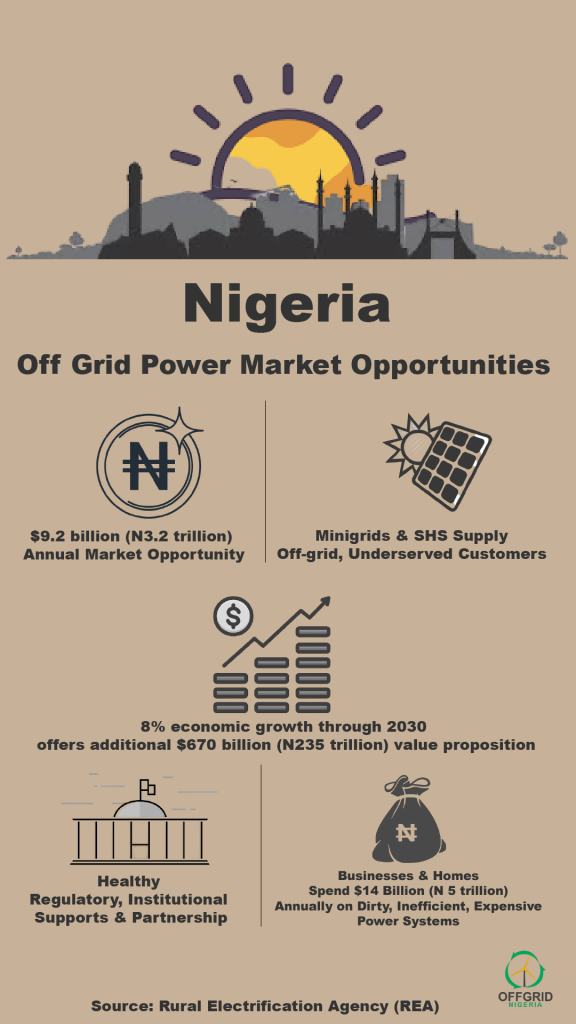Chukwunomnso Okeke*; Lotenna Nwana* and Ifeoma Malo*
Nigeria is blessed with an abundance of natural resources – hydropower, wood, wind and sunlight – all of which can meet its energy needs. Based on the installed capacity, Nigeria has the potential to supply 12,522 megawatts of electricity, yet it averages a 4,000 megawatts supply daily, which is grossly insufficient. The limited energy supply is as a result of multiple factors, which includes bad governance, mismanagement of resources, poor connectivity to the grid, antiquated and inefficient transmission network, and a complete lack of connection to the grid in several rural areas. Therefore, it comes as no surprise that Nigeria’s electricity consumption per capita remains at 115 kilowatts (as at January 22, 2021) and ranks amongst the lowest in the world, placing it in a position of 190 out of 219 countries. Due to the continuous increase in the population, the demand for electricity is rising and is anticipated to further increase by a factor of 16.8 by 2035.
However, due to low electricity access across the country, self-generation is adopted by many households in the country as a means of bridging the gap between the demand and supply of electricity. These energy needs are generally met through the use of diesel-powered generators, which contribute to environmental degradation through carbon emissions that reduce the air quality and accelerate climate change.
In its efforts to contain the spread of the COVID-19 pandemic, the Nigerian government made plans to purchase 100,000 doses of the vaccine – which is expected to arrive at the end of January. This is in line with the country’s goal of vaccinating 40% of the population in 2021. However, the two significant challenges exist in the government’s efforts at ensuring efficient distribution and storage of these vaccines. They are the lack of money, as well as adequate cold chain equipment infrastructure to deploy this efficiently. The Director-General of the Nigerian Institute of Medical Research (NIMR) Professor Babatunde Salako recently disclosed that the country currently lacks enough cold storage facilities to house the expected 100,000 vaccine doses, which puts these very expensive medicines at risk of going to waste. This dearth in CCE technology jeopardizes the government’s ability to ensure the effective transport of the vaccine from the point of manufacture to the point of administration. In order to combat the latter, the Federal Government of Nigeria has now secured private sector actors to provide cold chain equipment and facilities for the effective storage and distribution of the vaccines.
The effective distribution of the COVID-19 vaccine across Nigeria must also account for the existence of several remote rural areas, which are very difficult – if not impossible – to reach using insulated trucks and other cold storage vehicles. Most, if not all, of these areas are plagued by limited, intermittent electricity supply – several are completely disconnected from the grid – which will have major implications for the storage of the vaccines using even conventionally-powered refrigeration/freezing methods.
In light of Nigeria’s grossly insufficient energy supply and an ever-increasing demand, the Federal Government – through the Rural Electrification Agency – developed a geospatial model in 2019 to achieve universal electrification in Nigeria by 2024. The geospatial model was to serve as the basis for a nationwide Integrated Energy Plan, but it has four significant limitations which render it obsolete. These limitations are: (a) most of the data contained in its use used is outdated (b) it is not yet an open-source tool for public and private sector (c) it does not address clean cooking and (d) It was developed prior to COVID-19 – hence it does not account for the cooling and energy requirements of a COVID-19 vaccine rollout plan. Therefore, there is the need as a policy and planning priority by the Federal Government of Nigeria, for the development of a new integrated energy plan that will account for the shortcomings of its predecessor, and will address the above mentioned gaps, whilst building upon its strengths.
To ensure a proper and holistic vaccine roll-out, there is the need to consider the innovation that is taking place in the solar industry. As far back as 2010, for instance, the World Health Organization (WHO) pre-qualified the Solar Direct Drive (SDD) technology, which makes use of ice instead of batteries to store the energy from the sun. This technology was leveraged by Vestefrost – a UNICEF industry partner – to manufacture a 19.5 litre prototype unit of Cold Chain Equipment, The benefits of the Solar Direct Drive includes the elimination of the use of batteries that are vulnerable to theft and degradation. This technology also eliminates the use of fluorocarbons – replacing them with hydrocarbons – and further eliminates the use of fossil fuels. Since then, more research and development has been carried out in the cold chain industry, and the SDD technology is capable of adequately functioning in areas with temperatures up to 320C, which is quite suitable for Nigeria. More innovative and unconventional solutions like this are potential avenues that the Federal Government of Nigeria can employ to improve its cold storage capacity. To that effect, the Federal Government of Nigeria has acquired three ultra-cold freezers to keep the Pfizer vaccines at the required temperature. The country must continue to seek out other innovative solutions to these unique obstacles it will need to overcome in order to formulate the most effective distribution plan for the country.
There is also the need for transparency in the process, which includes ensuring that bids associated with this process are public in order to build public confidence as well as ensure a cost-benefit analysis of combining solar powered cold chain equipment with conventional means of vaccine delivery and storage where the former is inadequate. This process will also identify vendors who will supply cold chain equipment, and ensure a proper vetting process to ensure that these vendors have the capacity to meet the needs of the population. We should go a step further and suggest a public register of potential cold chain vendors, the different products and services they offer, and the cost of procuring the Cold Chain Equipment. This will provide insight, and will aid verification and transparency into the cost of distributing the vaccines to the various areas where they are needed, as well as estimate the cooling and energy costs of storing the vaccines until they are administered.
As earlier highlighted – the issue of mapping the vaccine roll-out will further support Nigeria’s integrated energy plan which will include executing a geospatial analysis that will include identifying high priority areas in terms of vaccine delivery (including health workers, top government officials and vulnerable people will be given priority). It also involves identifying areas that do not have adequate infrastructure to cater to the requirements of the cold chain equipment. Based on these criteria, a priority list is developed in order to identify areas (states) that require greater investments with the intention of avoiding arbitrary distribution and addressing the complaints of nepotism already associated with the vaccine distribution. According to the most recent information from the federal government on vaccine distribution, Kano state will receive the highest number of vaccines (3,557) while Bayelsa will be among the least catered to, receiving only 589 doses. This is despite the Nigerian Centre for Disease Control (NCDC) certified data showing that Lagos state and the F.C.T. have the two highest numbers of lab-confirmed COVID-19 cases in Nigeria with over 46,000 and 16,000 respectively, while the total number of confirmed cases in Kano state is 2,862 – a mere fraction of the cases in the aforementioned two states. At first glance, it seems counterproductive if not entirely confusing that these two states do not have the highest number of vaccines allocated to them. Lagos, the most affected state, has the second-highest number of vaccine allocations at 3,131 – which should be appreciably more – while the F.C.T. was allocated a measly 695 doses. This raises the question of what criteria were implemented in devising the distribution plan. Those more versed in the intricacies of Nigerian politics and policy-making, will undoubtedly point to tribal sentiments and geo-political favouritism as the key culprits in this glaring disconnect. They will insist that the vaccine allocation plan was directly motivated by the “base sentiment and clannish politics” of public officials who may have made it a priority to “look after their own”. Others may speculate that the official COVID-19 figures are only a fraction of the true total of infected people, and the government is aware of it – citing the high number of deaths in the state in March 2020 that the government repeatedly insisted was wholly unrelated to the pandemic. Regardless, the spread of COVID-19 has remained largely unchecked in Nigeria, and the government can douse the flames of conspiracy theories and questions about its integrity by making its distribution plan more equitable and transparent.
There is also the need to look at the mode of distribution and transporting the vaccines to the various communities, taking into consideration the lack of adequate road channels in Nigeria. This includes identifying alternative means of distributing vaccines when the primary or preferred option is not appropriate for a specific location; for example, adopting airlifts or waterways when the roads are bad. It must also account for ways to effectively distribute vaccines in the context of the security concerns in Nigeria, such as highway bandits, terrorism, ethnic clashes and other forms of violence.
It is also not too soon to speak about adequate maintenance of the Covid-19 cold chain equipment as they can be deployed to support a lot of our rural and community health interventions. There is the need for continuous training of health workers in these communities to ensure the correct use of the supplied cold chain equipment. There is also the need to encourage the state government to make policies, carry out sensitization visits and create educational materials aimed at discouraging citizens from misusing and destroying cold chain equipment.
Chukwunomnso Okeke* is a Research Analyst at Clean Technology Hub
Lotenna Nwana* is a Junior Analyst at Clean Technology Hub
Ifeoma Malo* is the CEO of Clean Technology Hub





